2010 PEUGEOT 3008 brake
[x] Cancel search: brakePage 160 of 315
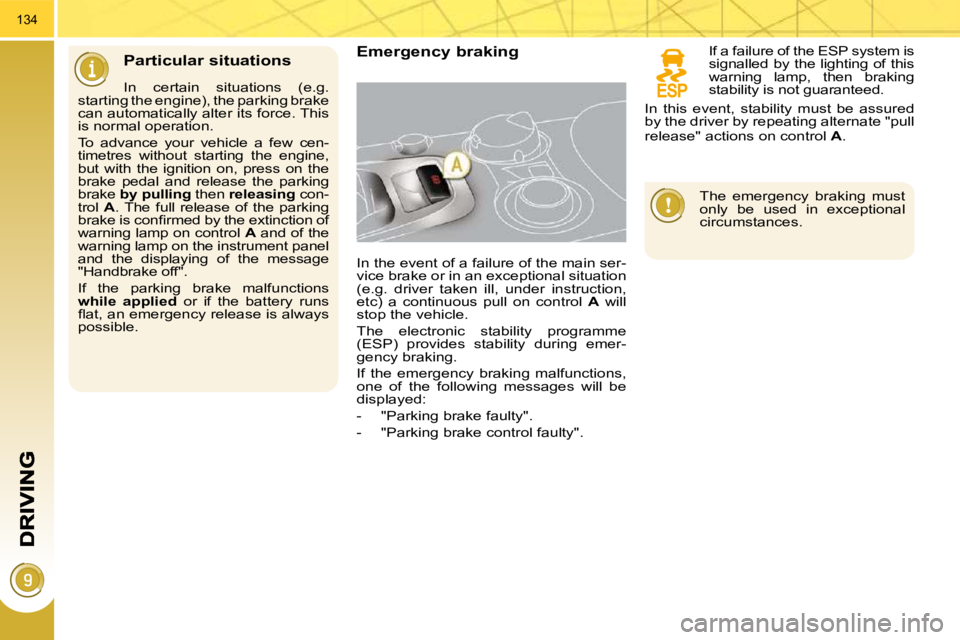
134
Particular situations Emergency braking
In the event of a failure of the main ser-
vice brake or in an exceptional situation
(e.g. driver taken ill, under instruction,
etc) a continuous pull on control A will
stop the vehicle.
The electronic stability programme
(ESP) provides stability during emer-
gency braking.
If the emergency braking malfunctions,
one of the following messages will be
displayed:
- "Parking brake faulty".
- "Parking brake control faulty".
In certain situations (e.g.
starting the engine), the parking brake
can automatically alter its force. This
is normal operation.
To advance your vehicle a few cen-
timetres without starting the engine,
but with the ignition on, press on the
brake pedal and release the parking
brake by pulling then releasing con-
trol A . The full release of the parking
�b�r�a�k�e� �i�s� �c�o�n�fi� �r�m�e�d� �b�y� �t�h�e� �e�x�t�i�n�c�t�i�o�n� �o�f�
warning lamp on control A and of the
warning lamp on the instrument panel
and the displaying of the message
"Handbrake off".
If the parking brake malfunctions
while applied or if the battery runs
�fl� �a�t�,� �a�n� �e�m�e�r�g�e�n�c�y� �r�e�l�e�a�s�e� �i�s� �a�l�w�a�y�s�
possible. If a failure of the ESP system is
signalled by the lighting of this
warning lamp, then braking
stability is not guaranteed.
The emergency braking must
only be used in exceptional
circumstances.
In this event, stability must be assured
by the driver by repeating alternate "pull
release" actions on control
A .
Page 161 of 315
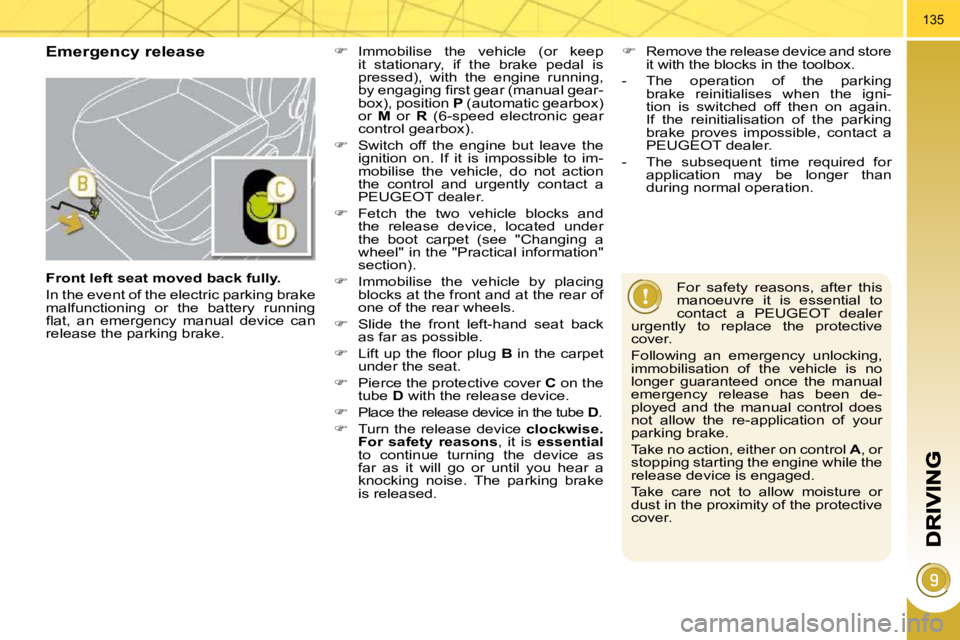
135
Emergency release
For safety reasons, after this
manoeuvre it is essential to
contact a PEUGEOT dealer
urgently to replace the protective
cover.
Following an emergency unlocking,
immobilisation of the vehicle is no
longer guaranteed once the manual
emergency release has been de-
ployed and the manual control does
not allow the re-application of your
parking brake.
Take no action, either on control A , or
stopping starting the engine while the
release device is engaged.
Take care not to allow moisture or
dust in the proximity of the protective
cover.
� Immobilise the vehicle (or keep
it stationary, if the brake pedal is
pressed), with the engine running,
�b�y� �e�n�g�a�g�i�n�g� �fi� �r�s�t� �g�e�a�r� �(�m�a�n�u�a�l� �g�e�a�r�-
box), position P (automatic gearbox)
or M or R (6-speed electronic gear
control gearbox).
� Switch off the engine but leave the
ignition on. If it is impossible to im-
mobilise the vehicle, do not action
the control and urgently contact a
PEUGEOT dealer.
� Fetch the two vehicle blocks and
the release device, located under
the boot carpet (see "Changing a
wheel" in the "Practical information"
section).
� Immobilise the vehicle by placing
blocks at the front and at the rear of
one of the rear wheels.
� Slide the front left-hand seat back
as far as possible.
� � � �L�i�f�t� �u�p� �t�h�e� �fl� �o�o�r� �p�l�u�g� � B in the carpet
under the seat.
� Pierce the protective cover C on the
tube D with the release device.
� Place the release device in the tube D .
� Turn the release device clockwise.
For safety reasons , it is essential
to continue turning the device as
far as it will go or until you hear a
knocking noise. The parking brake
is released.
� Remove the release device and store
it with the blocks in the toolbox.
- The operation of the parking brake reinitialises when the igni-
tion is switched off then on again.
If the reinitialisation of the parking
brake proves impossible, contact a
PEUGEOT dealer.
- The subsequent time required for application may be longer than
during normal operation.
Front left seat moved back fully.
In the event of the electric parking brake
malfunctioning or the battery running
�fl� �a�t�,� �a�n� �e�m�e�r�g�e�n�c�y� �m�a�n�u�a�l� �d�e�v�i�c�e� �c�a�n�
release the parking brake.
Page 162 of 315
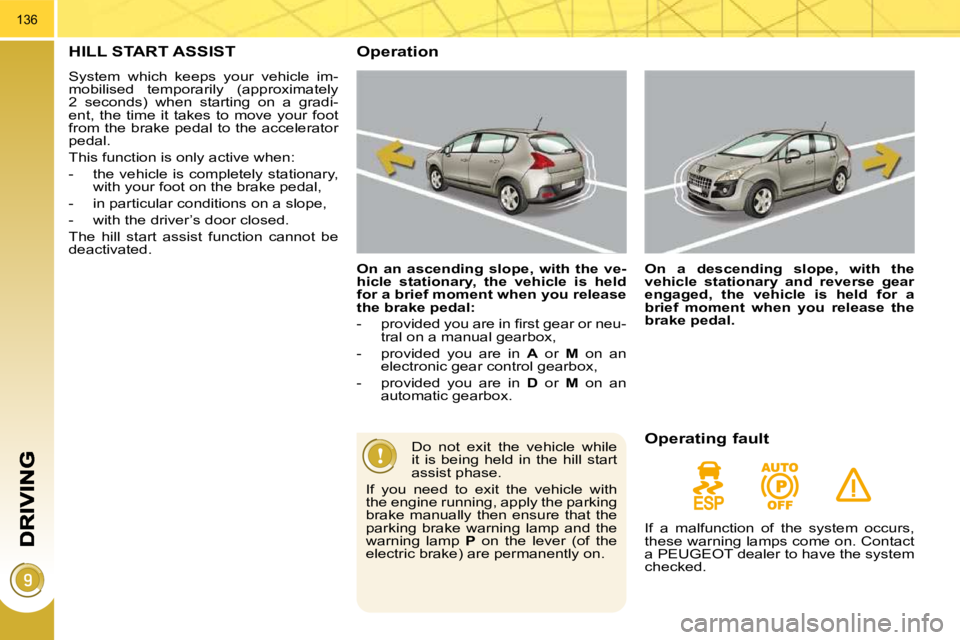
136
HILL START ASSIST
System which keeps your vehicle im-
mobilised temporarily (approximately
2 seconds) when starting on a gradi-
ent, the time it takes to move your foot
from the brake pedal to the accelerator
pedal.
This function is only active when:
- the vehicle is completely stationary, with your foot on the brake pedal,
- in particular conditions on a slope,
- with the driver’s door closed.
The hill start assist function cannot be
deactivated.
Operation
On an ascending slope, with the ve-
hicle stationary, the vehicle is held
for a brief moment when you release
the brake pedal:
� � � �-� � �p�r�o�v�i�d�e�d� �y�o�u� �a�r�e� �i�n� �fi� �r�s�t� �g�e�a�r� �o�r� �n�e�u�- tral on a manual gearbox,
- provided you are in A or M on an
electronic gear control gearbox,
- provided you are in D or M on an
automatic gearbox.
On a descending slope, with the
vehicle stationary and reverse gear
engaged, the vehicle is held for a
brief moment when you release the
brake pedal.
Do not exit the vehicle while
it is being held in the hill start
assist phase.
If you need to exit the vehicle with
the engine running, apply the parking
brake manually then ensure that the
parking brake warning lamp and the
warning lamp P on the lever (of the
electric brake) are permanently on.
Operating fault
If a malfunction of the system occurs,
these warning lamps come on. Contact
a PEUGEOT dealer to have the system
checked.
Page 169 of 315
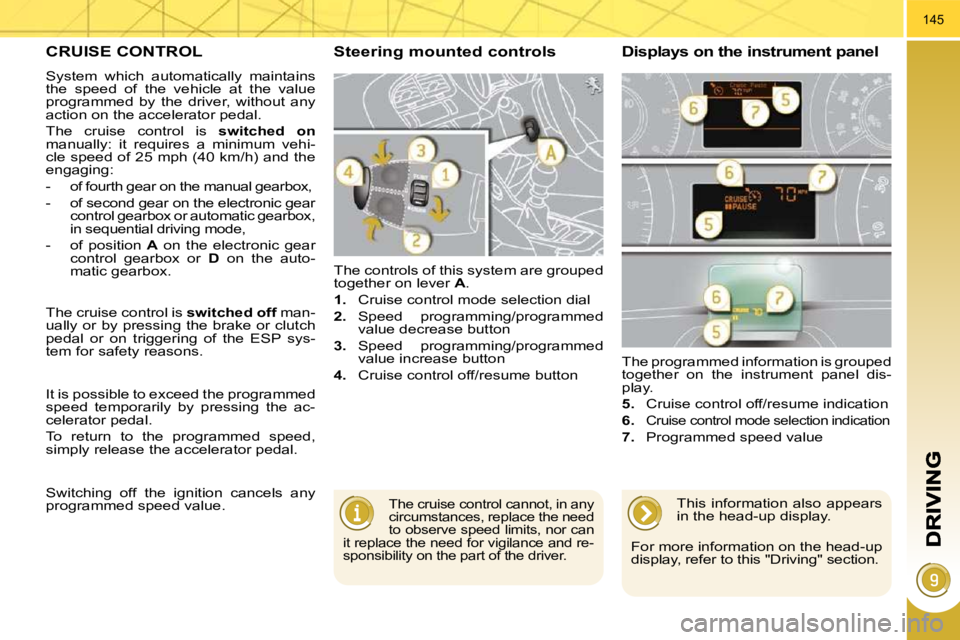
145
CRUISE CONTROL
System which automatically maintains
the speed of the vehicle at the value
programmed by the driver, without any
action on the accelerator pedal.
The cruise control is switched on
manually: it requires a minimum vehi-
cle speed of 25 mph (40 km/h) and the
engaging:
- of fourth gear on the manual gearbox,
- of second gear on the electronic gear control gearbox or automatic gearbox,
in sequential driving mode,
- of position A on the electronic gear
control gearbox or D on the auto-
matic gearbox. The controls of this system are grouped
together on lever
A .
1. Cruise control mode selection dial
2. Speed programming/programmed
value decrease button
3. Speed programming/programmed
value increase button
4. Cruise control off/resume button The programmed information is grouped
together on the instrument panel dis-
play.
5. Cruise control off/resume indication
6.
Cruise control mode selection indication
7. Programmed speed value
Steering mounted controls Displays on the instrument panel
The cruise control cannot, in any
circumstances, replace the need
to observe speed limits, nor can
it replace the need for vigilance and re-
sponsibility on the part of the driver.
The cruise control is switched off man-
ually or by pressing the brake or clutch
pedal or on triggering of the ESP sys-
tem for safety reasons.
It is possible to exceed the programmed
speed temporarily by pressing the ac-
celerator pedal.
To return to the programmed speed,
simply release the accelerator pedal.
Switching off the ignition cancels any
programmed speed value. This information also appears
in the head-up display.
For more information on the head-up
display, refer to this "Driving" section.
Page 172 of 315
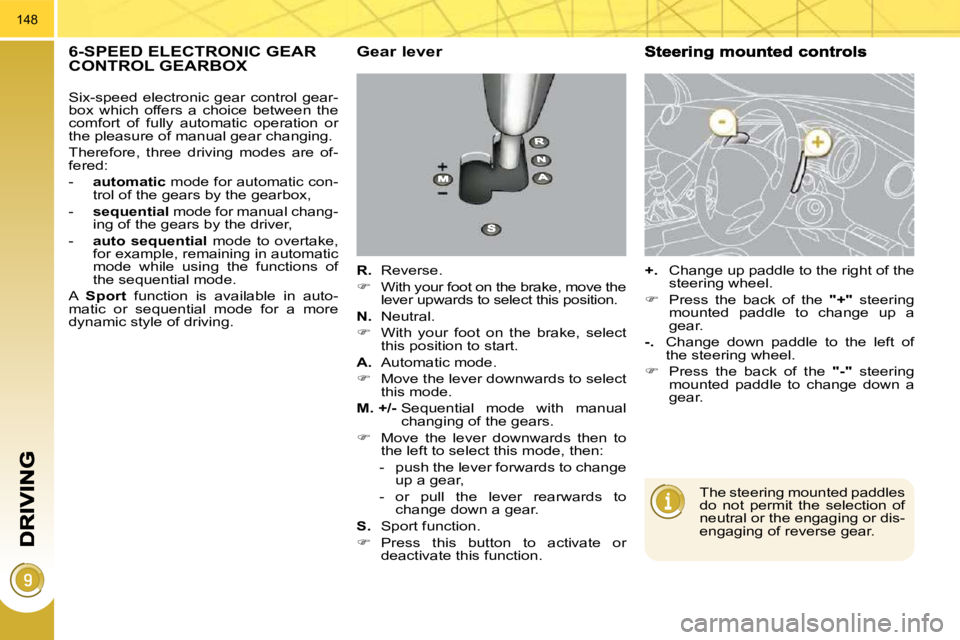
148
6-SPEED ELECTRONIC GEAR CONTROL GEARBOX Gear lever
R. Reverse.
� With your foot on the brake, move the
lever upwards to select this position.
N. Neutral.
� With your foot on the brake, select
this position to start.
A. Automatic mode.
� Move the lever downwards to select
this mode.
M. +/- Sequential mode with manual
changing of the gears.
� Move the lever downwards then to
the left to select this mode, then:
- push the lever forwards to change up a gear,
- or pull the lever rearwards to change down a gear.
S. Sport function.
� Press this button to activate or
deactivate this function.
+. Change up paddle to the right of the
steering wheel.
� Press the back of the "+" steering
mounted paddle to change up a
gear.
-. Change down paddle to the left of
the steering wheel.
� Press the back of the "-" steering
mounted paddle to change down a
gear.
The steering mounted paddles
do not permit the selection of
neutral or the engaging or dis-
engaging of reverse gear.
Six-speed electronic gear control gear-
box which offers a choice between the
comfort of fully automatic operation or
the pleasure of manual gear changing.
Therefore, three driving modes are of-
fered:
-
automatic mode for automatic con-
trol of the gears by the gearbox,
- sequential mode for manual chang-
ing of the gears by the driver,
- auto sequential mode to overtake,
for example, remaining in automatic
mode while using the functions of
the sequential mode.
A Sport function is available in auto-
matic or sequential mode for a more
dynamic style of driving.
Page 173 of 315
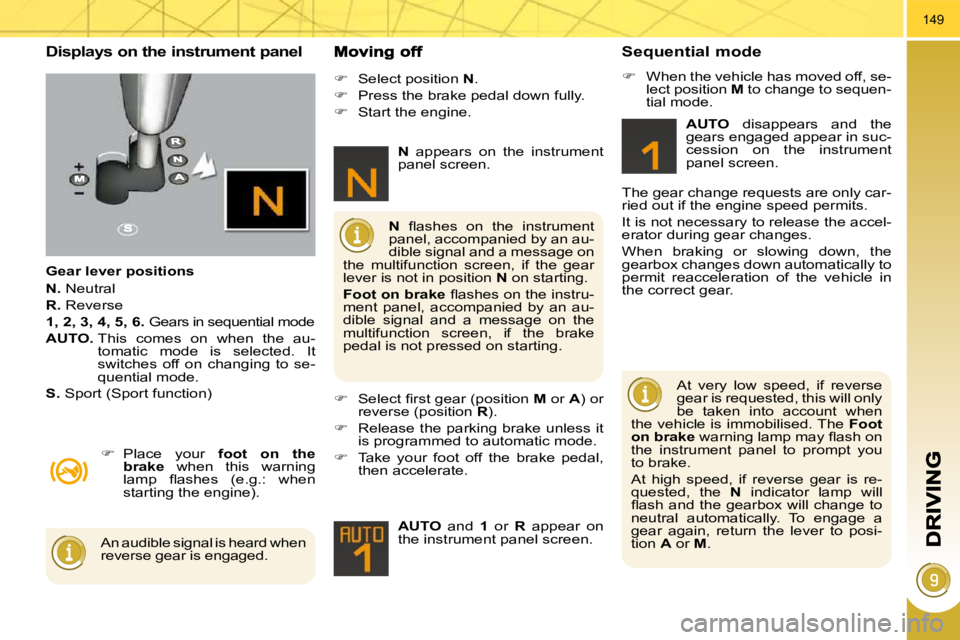
149
Displays on the instrument panel
Gear lever positions
N. Neutral
R. Reverse
1, 2, 3, 4, 5, 6. Gears in sequential mode
AUTO. This comes on when the au-
tomatic mode is selected. It
switches off on changing to se-
quential mode.
S. Sport (Sport function)
� Place your foot on the
brake when this warning
�l�a�m�p� �fl� �a�s�h�e�s� �(�e�.�g�.�:� �w�h�e�n�
starting the engine).
� Select position N .
� Press the brake pedal down fully.
� Start the engine.
� � � �S�e�l�e�c�t� �fi� �r�s�t� �g�e�a�r� �(�p�o�s�i�t�i�o�n� � M or A ) or
reverse (position R ).
� Release the parking brake unless it
is programmed to automatic mode.
� Take your foot off the brake pedal,
then accelerate.
AUTO and 1 or R appear on
the instrument panel screen.
N � � �fl� �a�s�h�e�s� �o�n� �t�h�e� �i�n�s�t�r�u�m�e�n�t�
panel, accompanied by an au-
dible signal and a message on
the multifunction screen, if the gear
lever is not in position N on starting.
Foot on brake � � �fl� �a�s�h�e�s� �o�n� �t�h�e� �i�n�s�t�r�u�-
ment panel, accompanied by an au-
dible signal and a message on the
multifunction screen, if the brake
pedal is not pressed on starting.
An audible signal is heard when
reverse gear is engaged.
N appears on the instrument
panel screen.
Sequential mode
� When the vehicle has moved off, se-
lect position M to change to sequen-
tial mode.
AUTO disappears and the
gears engaged appear in suc-
cession on the instrument
panel screen.
The gear change requests are only car-
ried out if the engine speed permits.
It is not necessary to release the accel-
erator during gear changes.
When braking or slowing down, the
gearbox changes down automatically to
permit reacceleration of the vehicle in
the correct gear.
At very low speed, if reverse
gear is requested, this will only
be taken into account when
the vehicle is immobilised. The Foot
on brake � � �w�a�r�n�i�n�g� �l�a�m�p� �m�a�y� �fl� �a�s�h� �o�n�
the instrument panel to prompt you
to brake.
At high speed, if reverse gear is re-
quested, the N indicator lamp will
�fl� �a�s�h� �a�n�d� �t�h�e� �g�e�a�r�b�o�x� �w�i�l�l� �c�h�a�n�g�e� �t�o�
neutral automatically. To engage a
gear again, return the lever to posi-
tion A or M .
Page 174 of 315
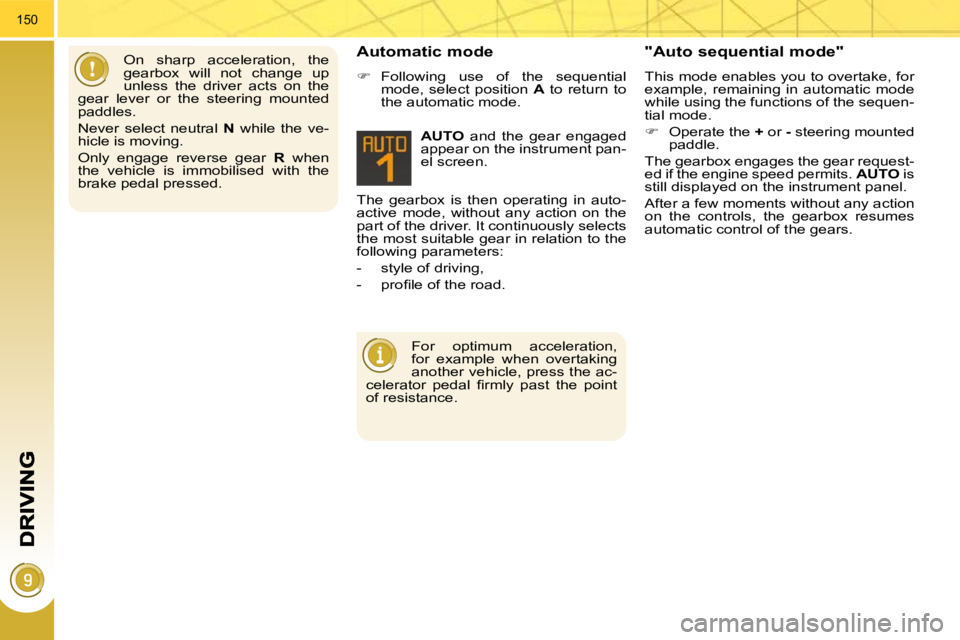
150
The gearbox is then operating in auto-
active mode, without any action on the
part of the driver. It continuously selects
the most suitable gear in relation to the
following parameters:
- style of driving,
� � �-� � �p�r�o�fi� �l�e� �o�f� �t�h�e� �r�o�a�d�.� �
AUTO and the gear engaged
appear on the instrument pan-
el screen.
Automatic mode
� Following use of the sequential
mode, select position A to return to
the automatic mode.
"Auto sequential mode"
This mode enables you to overtake, for
example, remaining in automatic mode
while using the functions of the sequen-
tial mode.
� Operate the + or - steering mounted
paddle.
The gearbox engages the gear request-
ed if the engine speed permits. AUTO is
still displayed on the instrument panel.
After a few moments without any action
on the controls, the gearbox resumes
automatic control of the gears.
On sharp acceleration, the
gearbox will not change up
unless the driver acts on the
gear lever or the steering mounted
paddles.
Never select neutral N while the ve-
hicle is moving.
Only engage reverse gear R when
the vehicle is immobilised with the
brake pedal pressed.
For optimum acceleration,
for example when overtaking
another vehicle, press the ac-
�c�e�l�e�r�a�t�o�r� �p�e�d�a�l� �fi� �r�m�l�y� �p�a�s�t� �t�h�e� �p�o�i�n�t�
of resistance.
Page 175 of 315

151
Stopping the vehicle Operating fault
With the ignition on, if this
warning lamp comes on and
AUTO � � �fl� �a�s�h�e�s�,� �a�c�c�o�m�p�a�n�i�e�d�
by an audible signal and a
message on the multifunction
screen, this indicates a malfunction of
the gearbox.
Have it checked by a PEUGEOT dealer.
It is essential to press the
brake pedal when starting the
engine.
When parking, is it essential to apply
the parking brake to immobilise the
vehicle, whatever the circumstances.
When immobilising the vehi-
cle, with the engine running, it
is essential to place the gear
lever in neutral N .
Before carrying out any work in the
engine compartment, check that the
gear lever is in neutral N and that
the parking brake is applied.
Sport function
� Following selection of the sequential
mode or automatic mode, press but-
ton S to activate the Sport function
which offers you a more dynamic
style of driving.
S appears next to the gear en-
gaged on the instrument panel
screen.
� Press button S again to deactivate
the function.
S is then cleared from the instrument
panel screen.
The gearbox returns to normal
mode automatically each time
the ignition is switched off. Before switching off the engine, you can
choose to:
- move to position
N to engage neutral,
- leave the gear engaged; in this case, it will not be possible to move
the vehicle.
In both cases, it is essential that you ap-
ply the parking brake to immobilise the
vehicle.